Installation at Gallery Puccs Contemporary, Budapest
June / July 2017
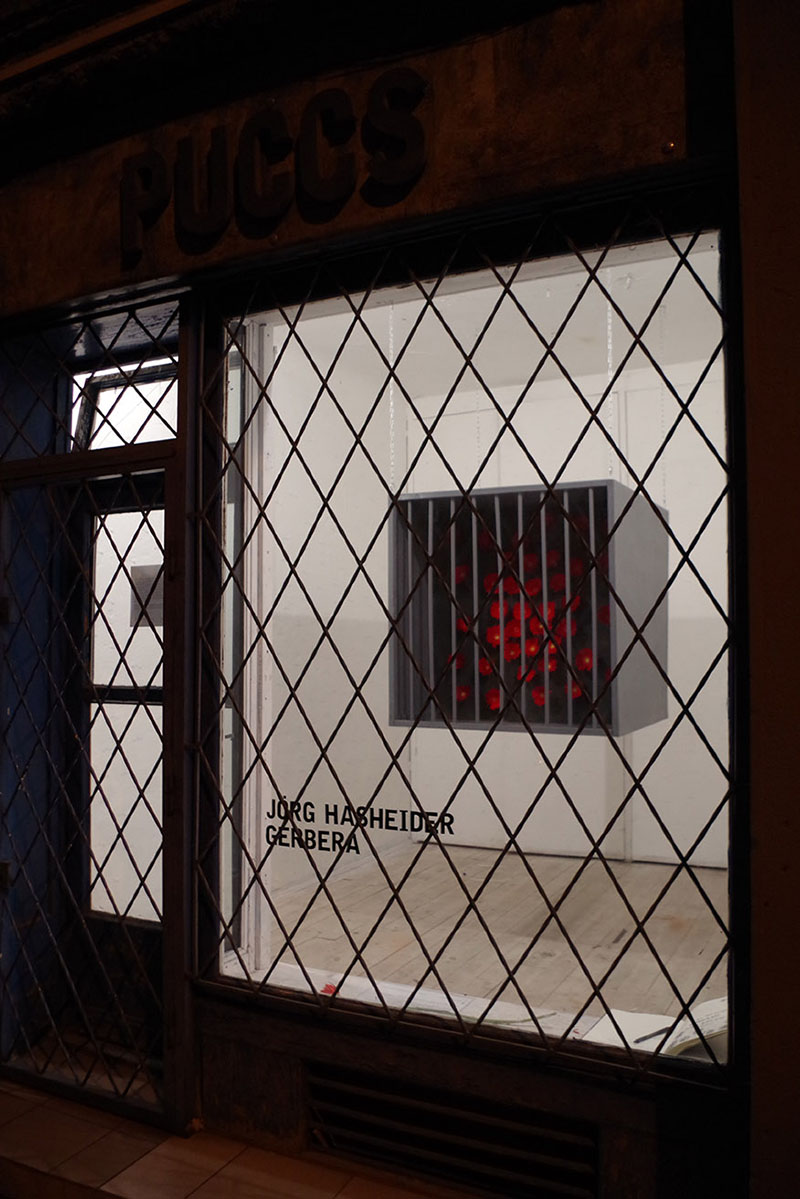 1 x 1 x 1 m cube, wood, metal chains, 40 flowers 2017
1 x 1 x 1 m cube, wood, metal chains, 40 flowers 2017

Installation at Gallery Puccs Contemporary, Budapest
June / July 2017
 1 x 1 x 1 m cube, wood, metal chains, 40 flowers 2017
1 x 1 x 1 m cube, wood, metal chains, 40 flowers 2017
Usambara (Hybrids)
diameter 22,5 cm 2017
Showroom Axel Nestle, Zwischenraum, Bieberach
Galerie Uli Lang, Bieberach
nightsky/matter 1 – 5
fluctuating 1 + 2 23 x 18 cm 2016
Showroom Axel Nestle, Zwischenraum, Bieberach
Galerie Uli Lang, Bieberach
Hochparterre Berlin / KunstSalon
pretty pressure dance
Showroom Axel Nestle, Zwischenraum, Bieberach
Hochparterre Berlin / KunstSalon
Exhibition at Neue Sächsische Galerie, Chemnitz , February / April 2017
Exhibition at Galerie Nord / Kunstverein Tiergarten Berlin in the frame of the European Month of Photography, October / November 2016
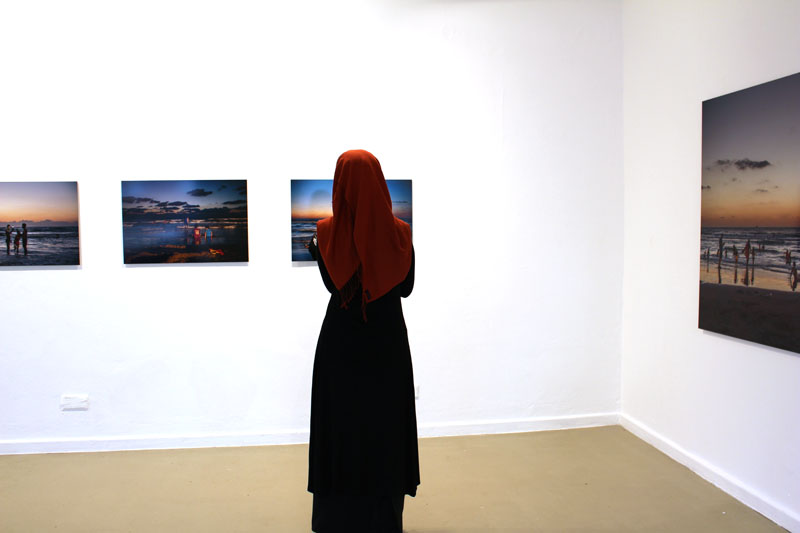
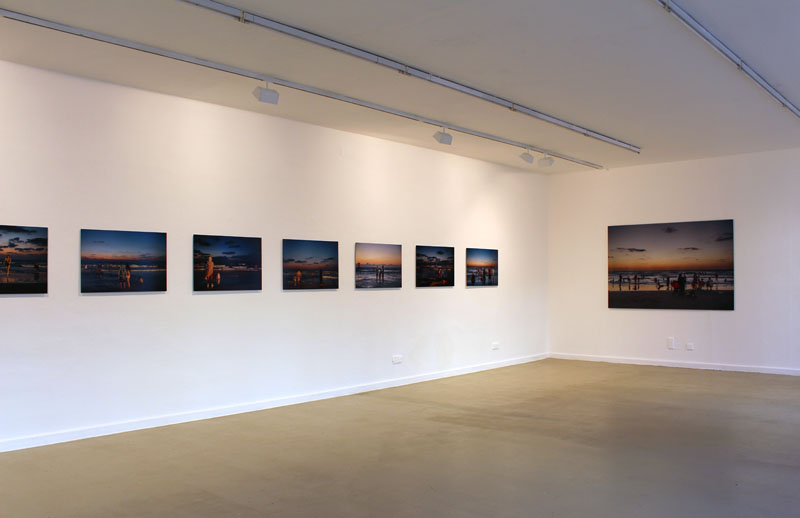 „one hour at the beach“, 8 photographies 75 X 50 cm, 2 photographies 180 x 120 cm
„one hour at the beach“, 8 photographies 75 X 50 cm, 2 photographies 180 x 120 cm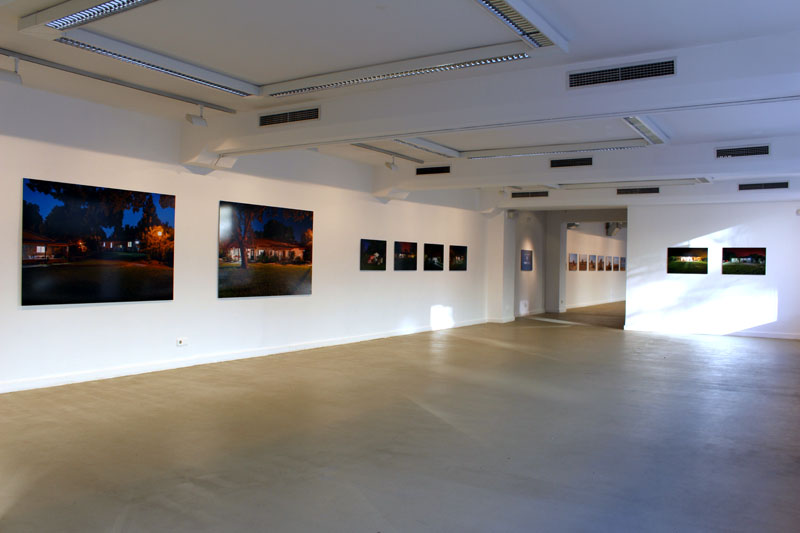 „privatized“, 8 photographies 75 X 50 cm, 2 photographies 180 x 120 cm
„privatized“, 8 photographies 75 X 50 cm, 2 photographies 180 x 120 cm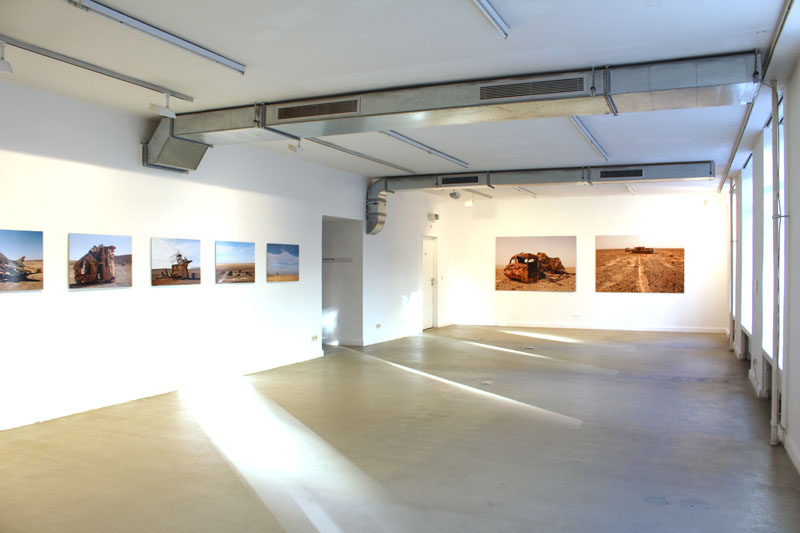 „targets“, 8 photographies 75 X 50 cm, 2 photographies 180 x 120 cm
„targets“, 8 photographies 75 X 50 cm, 2 photographies 180 x 120 cm
The exhibition comprises 3 series of 10 photographies that are dealing with social and political phenomena of Israel today. His themes are: the decay of the utopian vision of the first settlers, the way to treat ethnical and religious minorities and the neccessary absurdity of the israelian military. Ilan Nachum is dealing with these intricate, deeply ideologicaly and religiously rooted issues with great intelligence and ease, completely undogmatic and without any pathos. He virtously plays with the possibilties of documentary photography. Always keeping the necessary distance, his deep envolement in – and commitment to the photographed subject, life in israel, its problems, absurdities and beauty, is strongly perceptible.
Privatized
„… Kibbutz is an experiment that did not fail.“ Martin Buber In 2009 the Kibbutz movement celebrated its 100th anniversary. The long lasting and influentual utopian, socialist experiment started with the foundation of the first Kibbutz, Degania, in 1909. Over time it evolved and underwent changes, but its primary idea, the equality of all members, remaind, more or less, untouched. „From each according to his ability, to each according to his need.“ In the 1980s, with the privatization of the kibbutzim – different levels of income and private ownership – this primary quality begins to vanish. The loosening of the communal bonds in the Kibbutzim seems to go hand in hand with a change in the collective thinking of the Israeli society. In 2009 Ilan Nachum started a series of photographs, that, at first glance, document the typical housing of Kibbutzim. Underlyning the documentary appeal of the photographs is his use of similar angles and light situations, following the idea of the well-known german photographers Bernd and Hilla Becher: to define a type by the slight differences that become obvious when the objects are isolated and than aggregated in a sequence. Looking at the differences between the work of the Bechers and Ilan Nachum we find the core of his work „privatized.“ The Bechers document landmarks of a declining industry – connected with specific forms of technology and societies – that were often dismantled soon after they were photographed. Due to these circumstances the photographic representations become monuments of the photographed objects. Referent and sign fall in one. Ilan Nachum´s work is transcendent in a different way. His objects will remain. He is documenting a declining idea. He turns the usual iconography of the representation of life in a kibbutz – groups of children playing together, groups of people working together- upside down. The dwellings he photographs seem to be abandoned. The inhabitants that appear in a few of the pictures seem isolated and ghostlike in the bright light. In a strange but factual way the dwellings change their meaning from being representations and symbols of an egalitarian utopia to images of a classical suburban lifestyle.
One hour at the beach
This sequence shows the most crucial point of israeli social life: the coexistence of diffrent religious groups. The beach is a surrounding, where the social interactions of groups and individuals can be perfectly surveyed. It offers an almost neutral and empty space, in which the choice, where to settle yourself is determined by the relation towards others. The groups represented in the photogaphs are secular israelis and arabic muslims, easily identified by their divergent dress codes. Even when together, it is obvious, that there is no interaction between them. The art of Ilan Nachum shows people in an overwhelming and elementary set-up of beach, ocean and sunset. The chosen time – the sun has set and darkness sets in – is augmenting the existential expression of the work. The sheer beauty and intensity of the scenery integrates the various attitudes and shows people as they are: human beings enjoying and understanding life in respect to the elements of nature. Ideas of social or religious segregation seem vain.
Targets
This series is the most recent work of Ilan Nachum and it still is a work in progress. He has access to a restricted army district inside the Negev Desert, where he found constellations, that at first sight are reminiscent of landart pieces : strange constructions mounted on top of artifical hills, weird objects and circular arrangements. Placed within the wide and empty desert landscape they create a surrealistic impression, similar to the paintings of Dali or Tanguy. Looking closer at the objects an additional aspect comes into play: the objects are composed of scrap – military residue as well as refrigirators, metal bedframes, car parts, old barrels, etc. The objects are used as targets for the Israeli Air Force. They, in an almost touching way, are mimicking radar stations or rocket launches. The camera, as a documenting tool, is preserving a utilitarian fake, a manipulated reality. Layers of „The Real“ and the imaginary melt under the relentless desert sky.
The exhibition was supported by: 
Links:
Ilan Nachum
Neue Sächsische Galerie
Galerie Nord / Kunstverein Tiergarten
Installation on the 1st floor of the medival hospital „Altes Spital“
built from discarded GDR wall units.
More information about Inken Reinert, her installative and graphic work you find here:
All photographies by Inken Reinert
Poster by Frank Benno Junghanns
Video filmed at the opening,
29th of July, Kunstquartier Bethanien, Berlin
Silvia Beck, Laurence Egloff, Marco Goldenstein, Elke Graalfs, Anett Lau, Peter Nansen Scherfig, Veronika Schumacher, Wolf von Waldow, Dana Widawski
The ornament is back, back as wallpapers in fancy lofts, as filigree blinds in architecture and also back in the discourse of contemporary art. In the current art-production, two relations are particularly obvious: 1. Working with ornaments in their baroque function as space structuring elements relating architecture and art/design. 2.The deconstruction of ornamental structures that are looked upon as symbolic for opressive systems. In-between these formal and contentual, associative reference points – and beyond – there are almost endless possibilities to access „The Ornament“ and its long history. For thousands of years, ornaments were defining the appearence and the spiritual message of buildings and objects of everyday and ritual use. They integrated the progress of philosophical, religious and geometrical-mathematical thinking into more and more complex structures and gave them visual presence. The formal means of rhythmics and recursion – used since the Stone Age – establish a connection of being human – pulse, birth, death – and cosmic processes. In the 20th century, the concept of structuring surfaces and intertwining them with ordinal systems finds a new surface in the observation of corporative production and organisation.The ornament is less regarded as communicating stability and knowledge, but as a form incorporating force and power. Nowadays the ordinal system „Ornament“, formally and motivicly fractionalized, becomes the stage for the clash of systemic and individualistic thinking. Adopting the transcending concept of the ornament, while simultaneously transforming it subjectively, contemporary artists reestablish the ornament as an unconcerned, descretionary media. A media that makes it possible to connect images and tokens in new ways and structure walls and spaces. 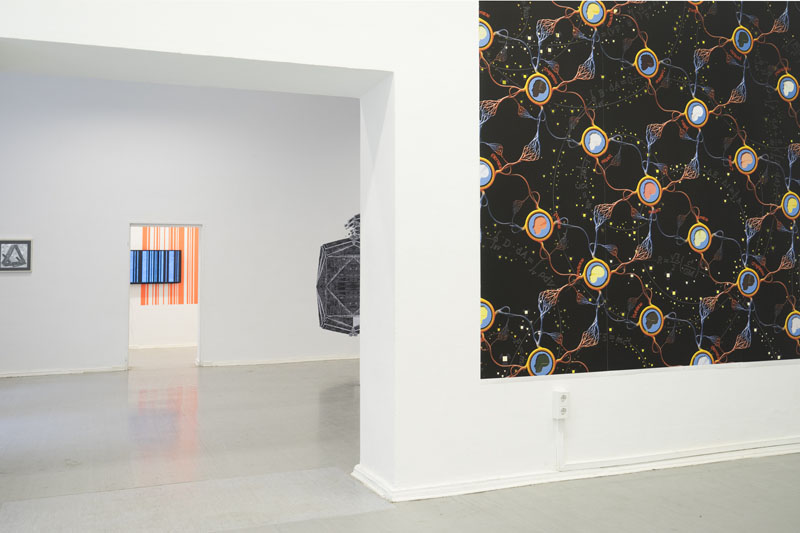 Silvia Beck, Veronika Schumacher, Wolf von Waldow
Silvia Beck, Veronika Schumacher, Wolf von Waldow 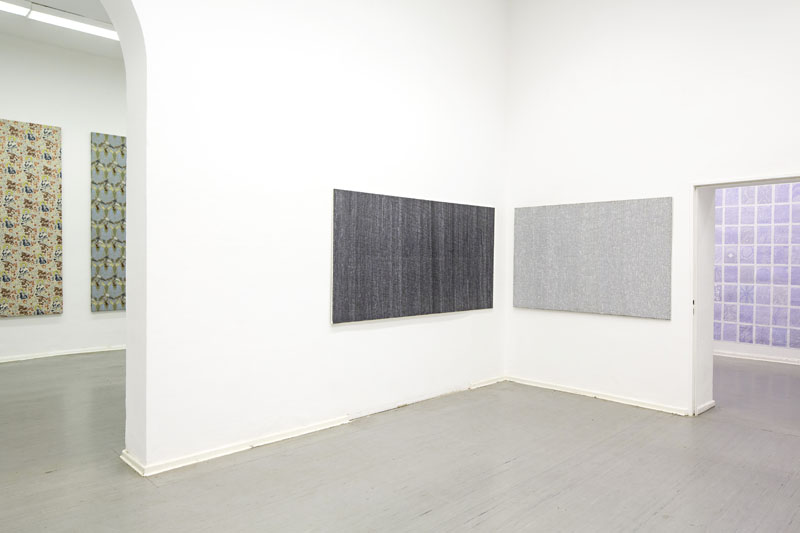 Dana Widawski, Elke Graalfs, Marco Goldenstein
Dana Widawski, Elke Graalfs, Marco Goldenstein 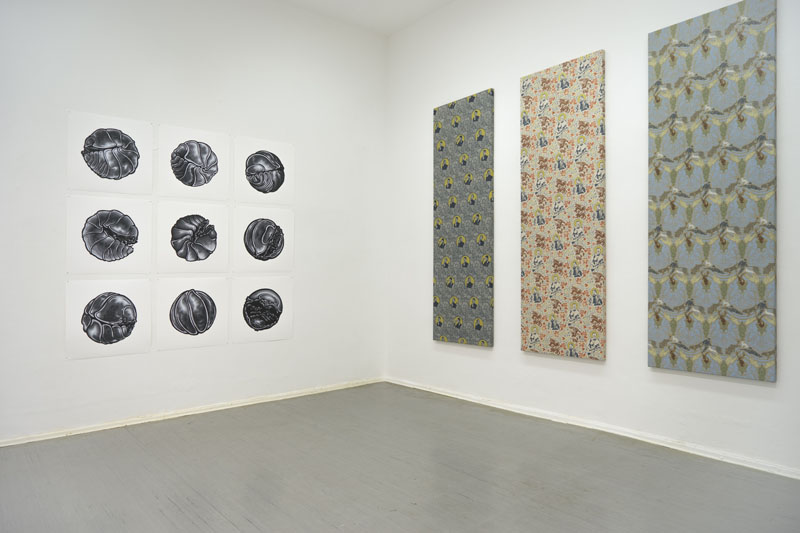 Peter Nansen Scherfig, Dana Widawski
Peter Nansen Scherfig, Dana Widawski
Silvia Beck
Dicionário de Dúvida, 2015 HD-video / screen, 02.32‘ Edition 1 + 3 by courtesy of Hafemann Internatiional
Laurence Egloff
On the 8th of April 2016, an extraordinary art event, True Mirror, takes place in Paris. The event is collectively organised by artists Laurence Egloff, Alexine Chanel, Alexandra Noat, Raphaël Renaud, Katharina Ziemke, Damien Cadiot as well as Mickaël Faure,curator and director of Versailles Art School. The whole group appeared as a snowball. An artist invited another one to contribute his or her work to the group collection. Altogether, a group of 58 artists from all over the world who were going to participate in the event was created.
The 58 works were shown to the artists so that each of them could choose one and then copy it. The choice of the medium was free, yet the initial format had to be followed.
The works that were copied, interpreted, and reflected on were presented to the artists without giving away the identity of the works. No information about the artists’ creative and academic background was revealed either. The works were completely decontextualised.
The related images were hung on the longitudinal walls one in front of the other in a symmetrical way in the exhibition hall.
That creates an effect of a mirror, but not in its physically reflecting sense.
2500 years ago, the Etruscans perceived the mirror as an instrument of philosophical and religious cognition of the unknown world whose phenomena they might not always explain. They regarded it namely as a gate to the unknown universe, so they engraved mythological scenes on the bronze surface placing them in an intricate order, which showed how fascinatingly impressive natural phenomena and they themselves were as perceived through the spiritual prism of their own eyes. Hence, the mirror was regarded as a mystical dimension in those days.
Since the Renaissance, the perception of physical phenomena has changed. Due to scientific progress mirrors started to be seen merely as optical instruments. Within the context of that period in the history of arts, as the human being started to be perceived as the centre of science and many of the secrets about the world were unveiled, the mirror was more and more often perceived as a scientific device.
As experiments with mirrors continued, Claude Lorrain (1600 – 1682) developed a mirror which was slightly convex. That mirror helped him to create his idealistic landscapes. Subsequently, at the height of the Enlightenment, it became popular with aristocracy who roamed around the outskirts of their estates in search of picturesque views.
Returning to our exhibition, through the opposition between the original and the copy, True Mirror, exposes another vision of the world, creates another kind of mirror by contrasting the Etruscan mirror conception with the materialistapproach that coincide in form of quotation-based and, consequently, epistemological postmodern culture.
Even a copy, being close to the original in terms of the structure and material, needs a soul and physical acquisition, a spiritual flow of an artist who produces the copy. Consequently, the works copied by the artists appeared to the surface of the world as a form of its contemplation and search of forms depicting its reality perceived subjectively.
True Mirror reflects the reflection of the reflection.
The surfaces are the horizons of soul penetration and the formal realisation. The visitor travels from wall to wall between the horizons.
Through the effect of doubling creative processes while determining the image, the work is transformed into another one of a similar type. That makes the visitor experience the complexity and diversity of the artist’s creativity and impressions.
The Etruscan mirrors of our age are particle accelerators and space-telescopes. The reflections appearing there reproduce the empirical knowledge about the unexplained as yet physical space.
The exhibition True Mirror reveals epistemological possibilities and borders through the reflection in imagination.
Jörg Hasheider, english translation: Cyril Gulevsky-Obolonski
Now for the third time we showcased the „paper icons“ exhibition. All informations are already available on this blog. Please scroll down for „paper icons, the dark matter version“ at Studio Haus am Lützowplatz and further on to „paper icons“ the studio exhibition.
At the opening, Weltaustellung was performing a great electro-accoustic set:
Copyright of photograhies by Norman Schupp
The exhibition was supported by Kulturamt der Landeshauptstadt Düsseldorf and
HPZ-Stiftung
Street Kabinett, Berlin, October 2015
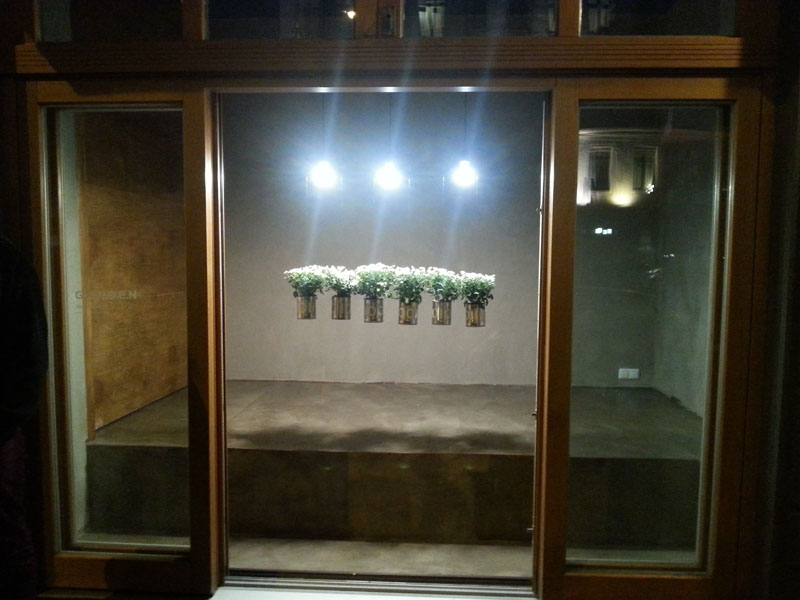
The starting point for „G.A.R.D.E.N“ is the observation of the different features of indoor gardening and gardening in its old meaning. The old meaning of gardening is the recreation of the primordial garden, the „Garden of Eden“, as a sheltered space of harmony and peace. However, it is not clear where indoor gardening is heading,
The reason, why we have lost paradise, being expelled from „Garden of Eden“, is the birth of conscience, the perception of a difference between „I“ and „It“, which led to naming „It“ – adam, eve, tree, snake a.s.o. -.This process of naming has never stopped and it will not stop until – following Vilem Flusser – we name everything: when the world gets cold and a new cycle starts.
Based on this narration the work deals with the problem of naming itself – the gap between signifier and the signified, codes – how to read the names when you cannot decipher the code they are written in, and the problem that we are sometimes confusing „It“ and its names.
And all in all it is an indoor gardened symbol for paradise lost.
Many thanks to Ronit and Matteo for filming and editing!
Street Kabinett is a non-profit space for experiments between site-specific installation and performance run by Opay L Goldberg, Sva Levy and Elisa Rusca.
Supported by: Linnen Berlin Bed & Breakfast
Altes Spital, Arnstadt, October 2015
Some impressions of the second „Identities“ exhibition. It comprised the same artists as the earlier show at „Pavillon am Milchhof“, but it showcased additional works of Alexine Chanel, Viola Kamp and myself. For further informations, please scroll down and have a look at the exhibition at Milchhof, April 2015. A documentation of Alexine Chanels new work you find here: the calling



 Photographies by Alexine Chanel Thanks to Christian, Andreas, Albrecht, Konstanze, Constance, Holger and all the voluntary helpers. The exhibition was supported by:
Photographies by Alexine Chanel Thanks to Christian, Andreas, Albrecht, Konstanze, Constance, Holger and all the voluntary helpers. The exhibition was supported by:  Ilm-Kreis and
Ilm-Kreis and 
Studio Haus am Lützowplatz June, July, August 2015
Ruprecht Dreher, Peter Freitag, Nicholas Kashian, HC Petersen, Oliver Ross, Marco P Schäfer
The exhibition „Paper Icons“ convenes six artists working within the material of paper under the theme „The Icon“.
Within the pieces in this exhibition, there are two distinct approaches : Firstly, the re-combination or subsequent eradication of iconic signifiers using found materials. Secondly, the construction of signs with an iconic appeal using blank material. Both approaches work with the deconstruction of the icon as a common signifier and the disengagement from its use as a guided association.
A disengagement that gives the recipient a heightened awareness of the allover iconic imprint of our society of the „Iconic Turn“ by opening up new spaces of association. (Introduction see below)
Ruprecht Dreher, Peter Freitag 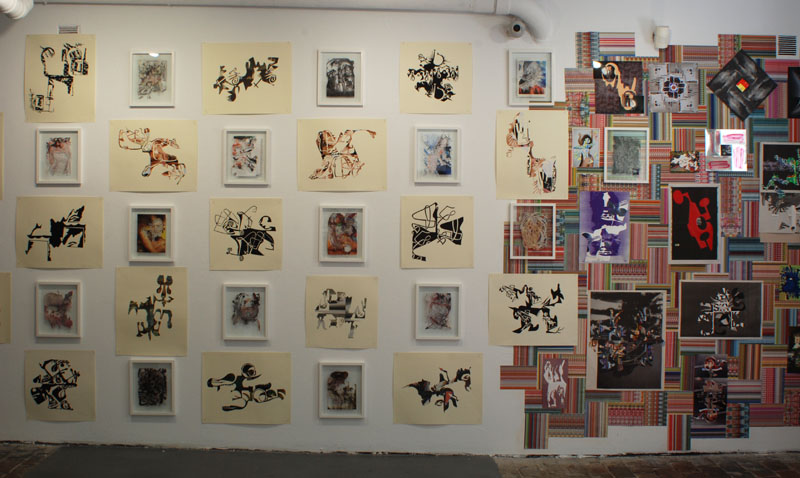
INTRODUCTION Dark Matter, the known unknown. An encompassing, unknown structure in which the known is sporadically flashing like peripheraly-filed engrams. Dark Matter constitutes 84.5 % of the materia of the univers and it eludes our perception. The visible materia that is fundamental for our perception is formed by hypothetic forces. With the iconisation of public space by „architectural icons“ and advertisments, the meaning and form building forces of social functions and social discourse fade into the background. An orientation towards form and a turning away from shaping shows up. The outstanding is not outstanding in its function anymore, but in its form–its symbolism.The world that occurs is imprinted by marketing and capital interests. It should be mentioned that art is part of semiocapitalistic industries. Signature pieces in signature rooms are standards in art marketing. The exhibiting artists use products of semiocapitalism as basic material for their deconstructions. Magazinpages, advertisements, porn, posters, quickly consumed iconic content on ephemeral material. The artists erase, cut out, recombine and displace both formally and contentwise. Porn without sex, adds without products, polaroids without photos. Icons become patterns and patterns become icons. The signature piece steps back behind the method of making the not seen, the ephemeral and accidental visible. Structures and patterns behind the icons, the message, emerge and open spaces of perception and free association.
Thanks to Galerie Kuhn & Partner for support!